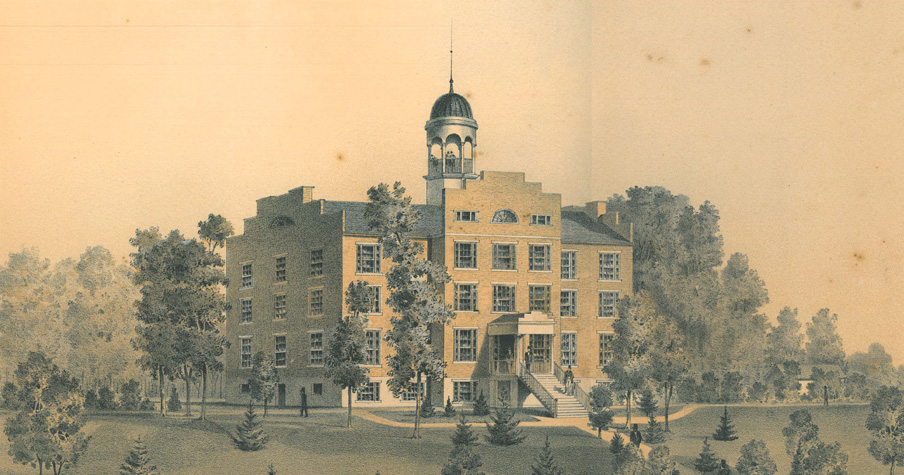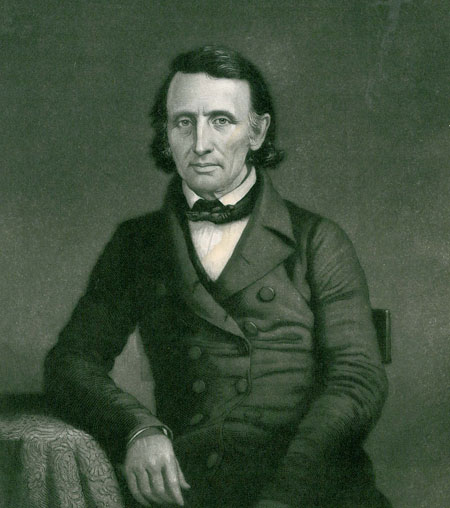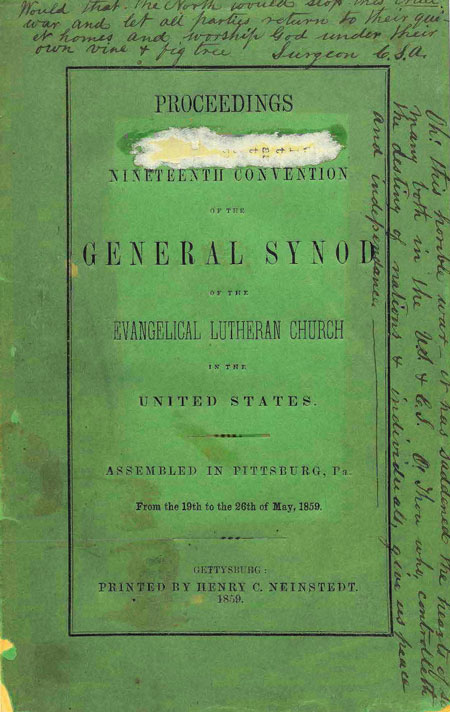
Photos Courtesy of Wentz library, United lutheran seminary
Seminary boards deal with all kinds of crises, but the board of directors of Gettysburg Theological Seminary in the early 1860s responded to a series of emergencies of truly epic proportions.
Even before the Civil War battle would engulf its very campus, Gettysburg board members faced unusual challenges. In 1861, students at the seminary and nearby Gettysburg College, located a few miles north of the Mason-Dixon line, formed a military company in response to (false) rumors of approaching enemy forces. The following year, “commencement week was so full of patriotic meetings ... that it was difficult to maintain a quorum at the sessions of the Seminary Directors,” wrote A. R. Wentz in his 1927 History of the Gettysburg Theological Seminary.

Seminarians, faculty, and seminary leaders (including President Samuel Simon Schmucker) shouldered patriotic and pastoral obligations as Confederate forces occupied a strategic battle position at the Gettysburg Seminary.
In June 1863, when President Abraham Lincoln and Pennsylvania Governor Andrew Gregg Curtain issued a call for Union volunteers, four seminarians and nearly 60 Gettysburg College students answered. They formed a new company, electing seminarian Frederick Klinefelter as captain and others as non-commissioned officers. (The college students included Samuel D. Schmucker, son of the seminary president; the son of seminary professor Charles Philip Krauth; and Edmund Wolf and Thomas Billheimer, who later became professors at the seminary.)
The company reported to Harrisburg, and the seminary board acknowledged this development at its meeting: “The Board has heard with proud satisfaction of the heroic conduct of those students of the Theological Seminary who rushed so promptly to the defense of their country during the late rebel invasion; and their course is hereby approved...”
Seminary President Samuel Simon Schmucker was a vocal abolitionist who had written and spoken against slavery for decades. As such, Wentz explained, “the citizens of the ‘Confederate States’ held him partly responsible for the War.…when Lee’s army moved into western Maryland and headed towards Pennsylvania, some of the soldiers declared their purpose to arrest Dr. Schmucker.” The Lutheran pastor in nearby Frederick, Maryland, George Diehl, was a Gettysburg Seminary graduate and board member; when he learned of the threat, he quickly notified Schmucker and urged him to flee. Schmucker did so, leaving his students and family before Confederate forces got to town.
Around the same time, those students who had just joined the Union Army were ordered to return to Gettysburg. They likely were not expecting to take up arms so close to where they had been studying theology. The seminary, however, had been built atop a hill, and the cupola of the main building provided a commanding view of the surroundings. Union General John Buford arrived on campus on June 30 and immediately climbed to the cupola, where he saw thousands of Confederate soldiers advancing from the west.
The seminary board sent an appeal to renovate and Refurbish the campus. donations poured in.
The Battle of Gettysburg began on the morning of July 1, 1863, with Union forces holding the seminary campus until late that afternoon. Then, outnumbered by Confederate forces, they started to retreat. “It swept through the Seminary Campus, demolishing fences and sheds and garden crops and almost everything that was perishable,” Wentz wrote. General Robert E. Lee moved in, and for the next two days the Confederate army occupied the seminary buildings and grounds. Lee’s aides used the same cupola vantage point that the Union had used a day earlier.
The deadliest battle fought in the United States was over in three days. The seminary buildings sustained major damage from cannonballs and smaller shells, and floors were stained with blood. Schumucker’s house (which included the seminary’s archives) was ransacked – likely by soldiers looking for Schmucker himself – but other campus buildings were not. Students found many of their personal belongings untouched.
The Gettysburg seminary community miracuously survived with no loss of life. The only injury Wentz reported was that of A. M. Whetstone, a student “wounded by a shot from a neighboring hotel where Confederate officers were known to be quartered.” (He recuperated and 15 years later, served as one of the Directors of the Seminary.)

Wounded Confederate troops were treated in the seminary, which had been re-purposed as a hospital. One soldier, writing on the cover of the 1859 General Synod minutes, penned a prayer for an end to the war.
After the fierce battle, more than 400 wounded Confederate soldiers recoverd at the seminary, which had been converted into a military hospital. The president of the board, Charles A. Hay, a Union stalwart, contacted the directors and friends of the school, saying, in part:
“In a few weeks the annual meeting of the Directors of the Seminary and Trustees of the College will take place, and, as president of the former Board, I take the liberty of suggesting to the friends of both institutions the propriety of sending...a liberal supply of hospital stores and comforts for the brave sufferers, who will still be lingering in the private houses and the hospitals near the scene of the conflict. At present such supplies have been forwarded in large quantities...but a month hence a contribution...will be doubly welcome. Let us not go emptyhanded,” he wrote.
While the battle caused destruction to the seminary property, the weeks of serving as a hospital caused much more. According to Wentz, students’ books and belongings were taken (library books were not), furnishings were damaged, and all blank paper was seized to write prescriptions. Working with the Gettysburg College trustees, the seminary board in September 1863 sent an appeal for funds to renovate and refurbish the campuses. Donations poured in, and the seminary received $2,346.18 of the $3,000 that the board estimated would be needed. Despite a shortage of labor and materials, repair work on the seminary was completed by summer 1864.
Today, tourists and history buffs flock to Gettysburg to visit the Seminary Ridge Museum and Education Center, housed in the historic building on United Lutheran Seminary’s campus. For the price of a ticket, you too can ascend the cupola and view the battleground that served as a turning point in the American Civil War.